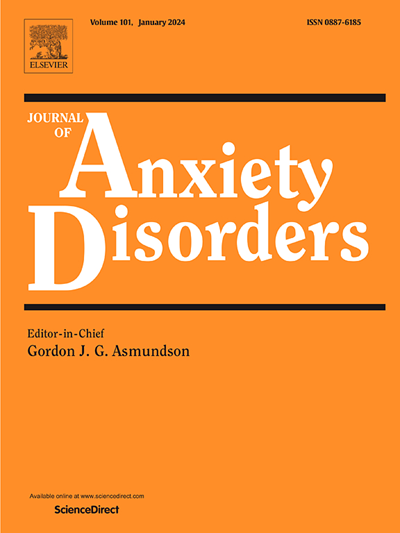在社会压力之前和期间心率变异性的变化和持续:有和没有社交焦虑障碍的个体的比较。
IF 4.5
2区 医学
Q1 PSYCHIATRY
引用次数: 0
摘要
患有社交焦虑障碍(SAD)的人对社交场合有明显的、持续的恐惧,因为他们预计会被拒绝、被审视和尴尬。鉴于对社交情境的生理反应可能会影响SAD患者的情绪体验,了解SAD患者的心理生理变化可能对解决这一潜在的关键持续因素很重要。本研究比较了两种心率变异性指数(HRV;使用Trier社会压力测试阶段(TSST),在SAD患者(n = 94)和非SAD患者(n = 59)之间,正常心跳和高频绝对单位之间的连续差异的均方根作为情绪调节的生理测量。结果显示,SAD组在准备(即期待)阶段增加了调节情绪的需求(HRV峰值),尤其是在女性中,而非SAD组的HRV在社会评价情境中达到峰值。与非SAD组相比,SAD组在准备阶段HRV的增加与假设的效果相反。非SAD组的HRV在某些阶段之间没有明显的持续性,而SAD组在所有阶段都有明显的持续性,但没有发现组间差异。这些发现提供了新的证据,证明在预测和遇到社会评价环境时,患有和不患有SAD的个体之间HRV的相似性和差异性。本文章由计算机程序翻译,如有差异,请以英文原文为准。
Changes and persistence in heart rate variability before and during social stress: A comparison of individuals with and without social anxiety disorder
Individuals with social anxiety disorder (SAD) experience significant and persistent fear of social situations as they anticipate rejection, scrutiny, and embarrassment. Given that physiological reactions to social situations may shape emotional experience in SAD, understanding psychophysiological changes operating in SAD may be important to address this potentially key perpetuating factor. This study compared the patterns of change (via contrasts of estimated marginal means) and persistence (via autoregressive models) of two indices of heart rate variability (HRV; Root Mean Square of Successive Differences between normal heartbeats, and High-Frequency absolute units) as physiological measures of emotion regulation, between individuals with SAD (n = 94) and without (n = 59) using the Trier Social Stress Test phases (TSST). Results revealed that the SAD group increased their need to regulate their emotions (peak HRV) during the preparation (i.e., anticipation) phase, particularly among women, whereas HRV peaked for the non-SAD group during the social-evaluative context. The SAD group’s increase in HRV in the preparation phase, relative to non-SAD group, was the opposite of the hypothesised effect. The non-SAD group demonstrated no significant persistence of HRV between some TSST phases, whereas the SAD group showed significant persistence across all phases, however no between-group differences were found. These findings provide novel evidence of similarities and differences in HRV between individuals with and without SAD while anticipating and encountering social-evaluative contexts.
求助全文
通过发布文献求助,成功后即可免费获取论文全文。
去求助
来源期刊

Journal of Anxiety Disorders
Multiple-
CiteScore
16.60
自引率
2.90%
发文量
95
期刊介绍:
The Journal of Anxiety Disorders is an interdisciplinary journal that publishes research papers on all aspects of anxiety disorders for individuals of all age groups, including children, adolescents, adults, and the elderly. Manuscripts that focus on disorders previously classified as anxiety disorders such as obsessive-compulsive disorder and posttraumatic stress disorder, as well as the new category of illness anxiety disorder, are also within the scope of the journal. The research areas of focus include traditional, behavioral, cognitive, and biological assessment; diagnosis and classification; psychosocial and psychopharmacological treatment; genetics; epidemiology; and prevention. The journal welcomes theoretical and review articles that significantly contribute to current knowledge in the field. It is abstracted and indexed in various databases such as Elsevier, BIOBASE, PubMed/Medline, PsycINFO, BIOSIS Citation Index, BRS Data, Current Contents - Social & Behavioral Sciences, Pascal Francis, Scopus, and Google Scholar.
 求助内容:
求助内容: 应助结果提醒方式:
应助结果提醒方式:


